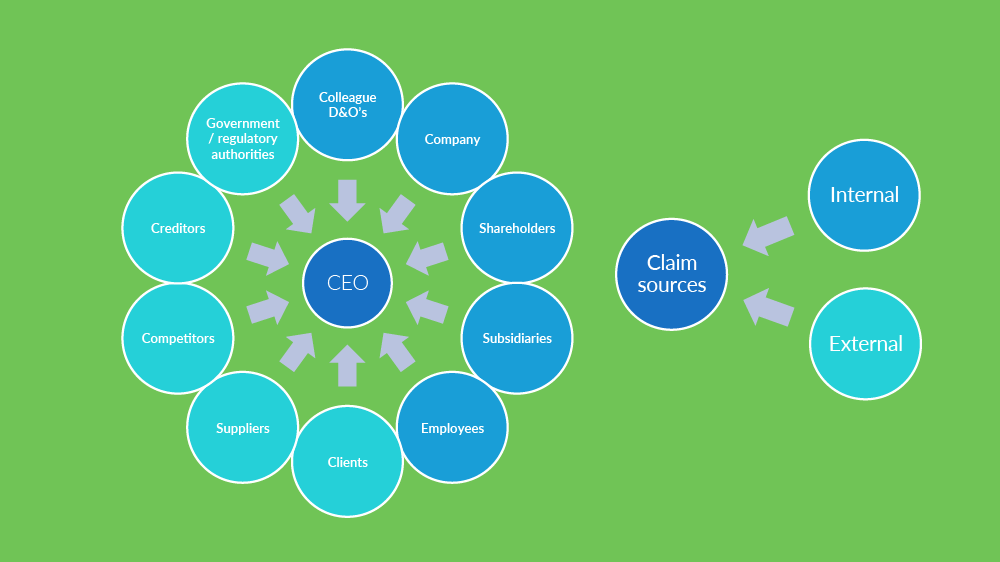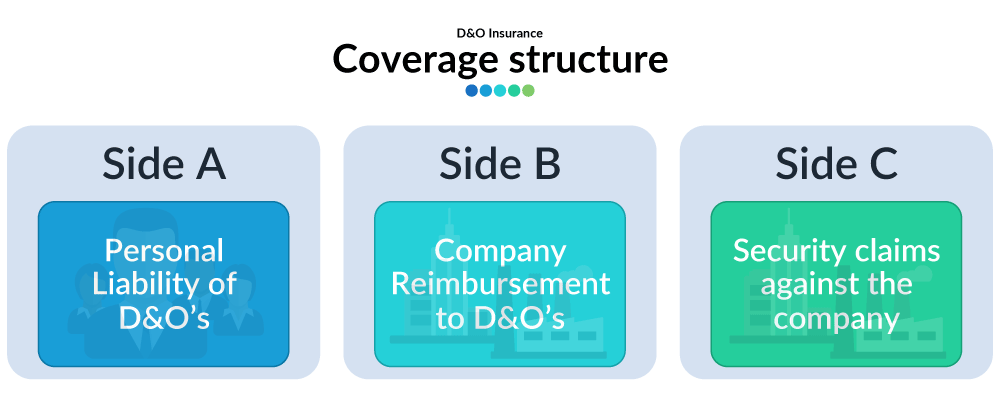Duties and obligations of D&O's
The directors and officers have a personal liability in case they do not act in line with their duties and responsibilities (for example art. 2:9 BW / Dutch law or part 10 item 171-177 Companies Act 2006 / “UK law”).
The Uk Companies Act summarises the duties directors need to fulfil and this will give you a good feeling of the requirements for a good performing director. The duties mentioned in the UK Companies Act 2006 are the following:
- Duty to act within powers
- Duty to promote the success of the company
- Duty to exercise independent judgment
- Duty to exercise reasonable care, skill and diligence
- Duty to avoid conflicts of interest
- Duty not to accept benefits from third parties
- Duty to declare interest in proposed transaction or arrangement
Internal and external parties that could file a claim against D&O's

All kinds of third parties, both internal and external, can initiate claims against D&O’s for losses they suffer as a consequence of wrongful acts committed by a director and/or officer of a company in their capacity as such. Below we have summarised the most common sources for claims:
- Internal parties
- Colleague D&O’s
- Company
- Shareholders
- Subsidiaries
- Employees
- External parties
- Clients
- Suppliers
- Competitors
- Creditors
- Government / regulatory authorities
Now that we have briefly established that there is a personal liability of the D&O's of a company we will explore how a directors' and officer's liability insurance (D&O Insurance) can help protect the personal assets of the D&O's.
D&O liability insurance

A directors’ and officers’ liability insurance (D&O) provides protection for the personal assets of the directors and officers in case they are held personal liable by a third party to compensate for loss caused by wrongful acts committed in their capacity as director or officer.
An D&O insurance is built around one or more insuring clauses commonly known as Side A, B and C. These insuring clauses together represent the main coverage of the D&O insurance, where:
- Side A covers the personal liability of the D&O’s in case the company does not provide indemnification.
- Side B reimburses the company in case the company provides indemnification to the D&O’s.
- Side C covers security claims against the company.
Side A + B are both covering the personal liability of the directors and officers, but differ in the party that which will receive the benefits form the D&O insurance. When the director or officer is not reimbursed by its company he or she will receive the benefits from the insurance. When the company has indemnified the director or officer the company will receive the insurance payments reduced by a applicable deductible (or self insured retention).
Contrary to Side A + B is the coverage provided by the Side C insuring clause a coverage for security related claims directed against the company itself.
Circle of Insureds
The insured parties under a D&O insurance are the following:
Natural persons
- Past, current en future Directors and Officers;
- Employees with a managerial of supervisory position;
- Employees in the capacity of co-defendant in claim against an Director or Officer;
- Employees in the capacity of compliance officer;
- Employees in the capacity of risk manager.
Company
- Policyholder;
- Subsidiaries (majority share / management control)
As you will have noticed the actual group of insured persons is much larger than the D&O's only. This is something to take into account when deciding on the limit of indemnity of the D&O insurance.
Coverage
The following financial loss components are covered under a D&O insurance:
- Damages that the insured is legally liable to pay;
- Settlements negotiated with the prior consent of the insurer;
- Defence costs.
As you will have noticed the D&O insurance does not only cover the actual loss of a third party, but also the defence costs that the D&O's incur while defending themselves against third party claims. The coverage for defence costs is a very important part of a D&O insurance because these costs can reach significant numbers in a very short period of time. Even when the D&O's are not liable they will need to defend them selves against claims and incur the related defence costs.
Additional coverages:
- (pre) Investigation costs;
- Fines and penalties (as far as insurable by law);
- Civil and Bail bond expenses;
- Reputational recovery costs.
Compared to other insurance types the D&O insurance is a relatively new kid on the block and due to its young age the insurance has been evolving rapidly which still results in regular enhancements and extensions.
Exclusions
There is no insurance without exclusions and the D&O insurance is no exception to this rule. The D&O insurance will be subject to a relative small number of exclusions such as:
- Conduct exclusion;
- Financial advantage / gaining profit to which the insured is not entitled;
- Intentional criminal acts / deliberately fraudulent act by an insured. Note: exclusion subject to final adjudication.
- Prior or pending litigation (prior to the inception date / prior to specific date mentioned in policy);
- Property Damage / Bodily Injury (defence cost covered due to carve back);
- Insured vs Insured (exclusion in Europe typically limited to US claims);
- Environmental Pollution (defence cost covered due to carve back).
We will address these items in more depth in future articles about the D&O insurance.
Extensions
Depending on the scope of coverage a D&O insurance may include the following extensions:
- Extended Reporting Period;
- Pre agreed terms on which the period in which claims may be reported to the insurer can be extended (up to 72 months).
- Marital Estates;
- Claims against lawful spouses or domestic partners solely in their capacity as such.
- Estates / Heirs / Legal representatives;
- Claims against estates / heirs / legal representatives of the insured person with respect to wrongful acts committed by the insured person.
- Outside Entity Executives / Outside Directorships Liability;
- D&O coverage for employees who at the specific request of the company serve as a Director or Officer of an outside entity (coverage is double XS: D&O coverage of the outside entity will prevail + coverage only for the Outside Entity Executive and not for the other D&O’s of the outside entity).
- Company Investigations;
- The D&O insurance pays for the fees, costs and expenses incurred with the consent of the insurer with respect to investigations into the affairs of the company.
- Excess Limit of indemnity for Non-Executive Directors;
- Provides an additional limit of indemnity to the non-executive directors in case the regular limits have been exhausted.
- Civil or Bail bond expenses.
- The insurer will pay on behalve of the insured the expenses for civil or bail bonds which are directly related to a covered claim under the D&O insurance.
- Retired officers
- In case the D&O insurance is not renewed or replaced by the company, the directors and officers who have “retired” from the company are entitled to an extended reporting period (up to 10 years).



